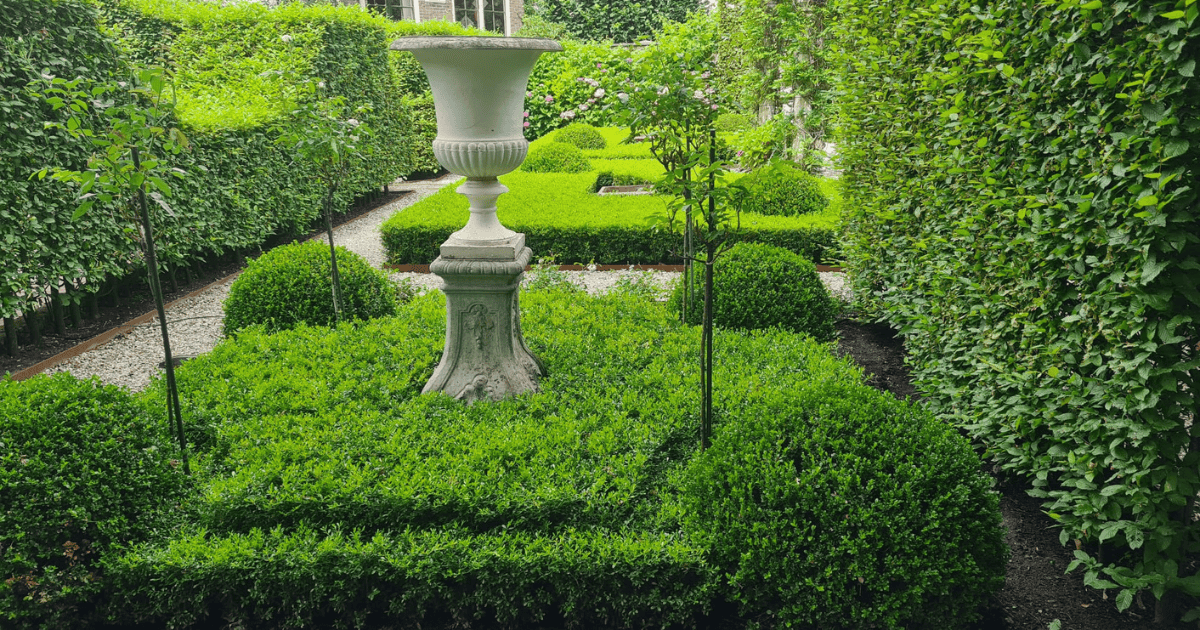

Hedges play many roles in the landscape, from space making to screening. They vary considerably in height and width depending on their function and can be created using a diversity of plant material. With dense, evergreen foliage and good tolerance to pruning, boxwood shrubs are a classic choice for creating hedges in both formal and informal gardens. Boxwood hedges are easy to grow, but their maintenance needs differ from that of shrubs planted individually. Learn how to properly space plants within a hedgerow and pruning strategies to maintain a formal or natural hedge.

Types of Hedges and Borders
A hedge is a row of closely spaced shrubs used to mark boundaries, define space, create barriers, or serve as windbreaks. Hedges range in height and density to serve these various roles. Low-growing borders are used to frame planting beds, while tall hedges act as privacy screens. The Better Boxwood collection includes four varieties with different growth habits, each creating a very different style of hedge.
Hedges can be roughly defined by their size and function.
Borders/Edging
Low growing borders are planted along the edge of beds to define space or delineate bed lines. They are commonly used to create the strong lines of knot gardens and parterres, as well as for framing potagers. Renaissance™ boxwood (1-2’ tall x 1-2’ wide) is an excellent selection for this application as plants maintain their size and shape with little pruning.
Medium Hedges
Midsized hedges are used to separate garden rooms without blocking the view into adjacent areas of the garden. They are also commonly used to establish boundaries and borders throughout the landscape. The symmetry of Heritage™ boxwood (3-4’ tall x 2-3’ wide) makes it well suited to formal hedges, framing entrances, and lining pathways. Babylon Beauty™ (3’ tall x 4-5’ wide) has a compact form that requires little pruning to maintain a formal or informal hedge.
Screens
Tall hedges are commonly used to delineate boundaries along the edge of the property and for creating privacy screens or windbreaks. Maturing at a height of six to eight feet, Skylight™ boxwood is perfect for screening backyards from neighboring properties, shielding porches from busy sidewalks, and establishing windbreaks around outdoor rooms.
When planning a hedge, consider the desired size as well as your garden style. Plants in a hedgerow can be maintained formally or allowed to grow to their natural form. The resulting hedges create very different aesthetics.

Spacing Plants in a Boxwood Hedge
The individual plants in a hedge are set closer together than they would be if planted individually. This close spacing allows the foliage of neighboring plants to grow together into a continuous canopy. Plant spacing in a hedgerow is based on the expected mature size of the variety and is measured from the center of one plant to the center of the neighboring plant.
The following spacing is recommended for creating beautiful hedges with Better Boxwood varieties.
- Babylon Beauty™: 18-24 inches
- Heritage™: 15-18 inche
- Renaissance™: 12 inches
- Skylight™: 18 inches

How to Prune a Boxwood Hedge
There are two basic types of pruning used to maintain boxwoods: pruning and shearing. These two methods are described in detail in the article Pruning, Shearing, Thinning – Oh My! Pruning cuts are used to thin the canopy which helps maintain plant health and control plant size. Boxwood hedges maintained in their natural form require only a light annual pruning.
Formal boxwood hedges are maintained through a combination of pruning and shearing. Shearing promotes dense growth at the tips of branches, which creates a thick outer canopy of foliage over time. This shell of leaves prevents light from reaching the inner branches and slows air flow to the plant interior, creating an environment conducive to foliar disease. To maintain a healthy hedge, shearing is paired with annual thinning to create openings in the canopy for air and light to penetrate.
Hedge Pruning Tips
- Thin boxwoods in late winter to early spring, before new growth emerges.
- Use hand pruners for small branches (up to ¾”) and loppers for larger branches (¾” to 1 ¾”).
- Cut branches back to a lateral branch inside the leaf canopy.
- Start by removing broken and dead branches, then selectively remove branches to open the canopy.
- Work slowly and step back frequently to observe the overall plant shape.
Hedge Shearing Tips
- Shear established plants in early summer after the first flush of growth.
- Young plants require additional shearing after each flush of growth during the first 2-3 years to encourage branching.
- Hand shears provide more control for small plants like parterres and knot gardens. Powered trimmers work well on larger hedges.
- Prune hedges wider at the base than the top to allow sunlight to reach lower branches.
Remember, sheared hedges also require winter pruning to thin the canopy. This two-step process ensures hedges remain healthy while producing the desired form.
To minimize your pruning needs, match the unique varieties of Better Boxwood to your gardening goals. Several varieties are slow growing, maintaining their size and shape with less pruning. And while plant size can be maintained through pruning, it is much easier to start with a variety that matures to the desired size. Proper plant selection, spacing, and maintenance will ensure your hedge remains lush and healthy for years to come.



